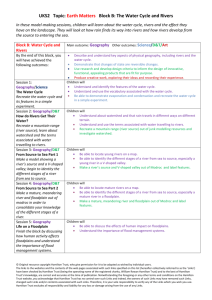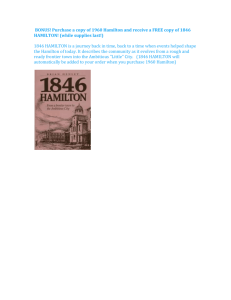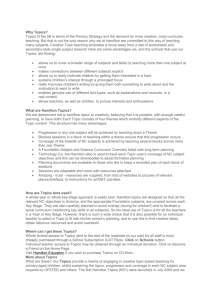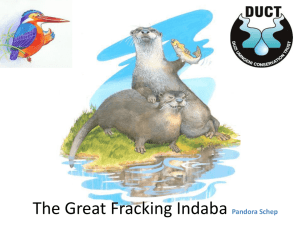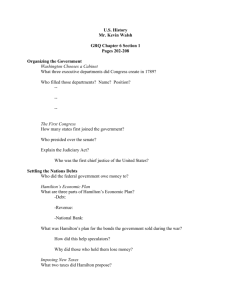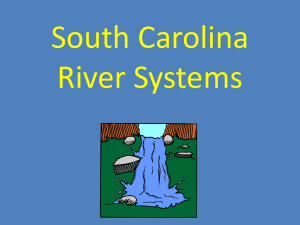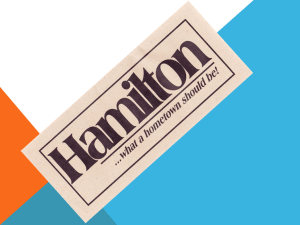Block Outcomes - Hamilton Trust
advertisement
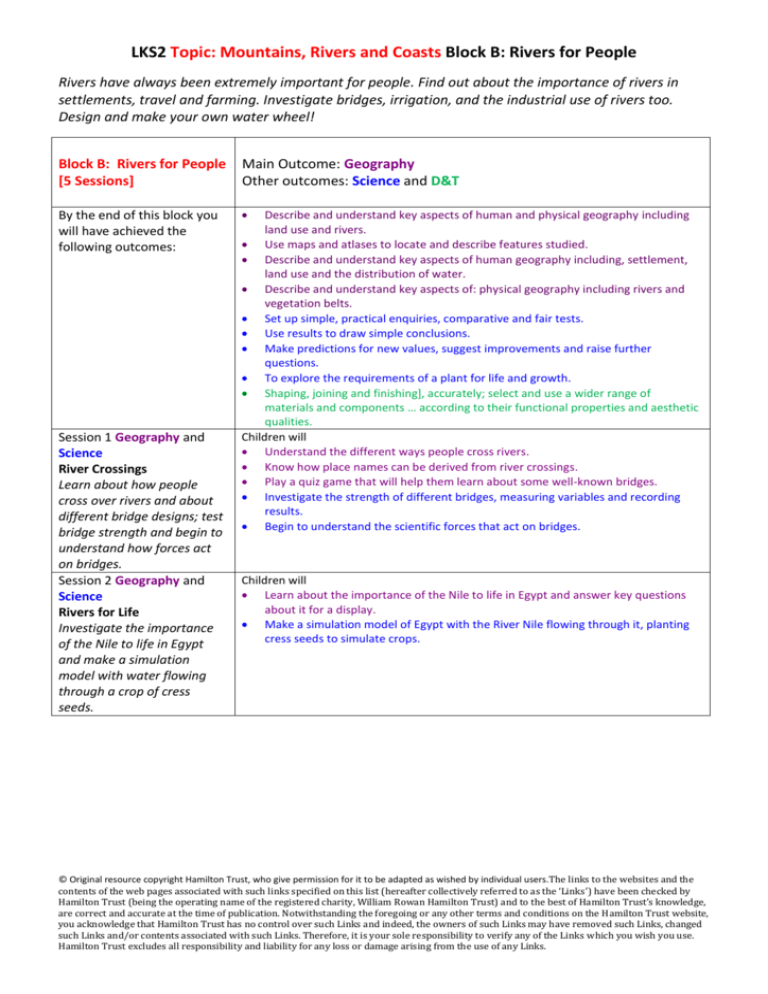
LKS2 Topic: Mountains, Rivers and Coasts Block B: Rivers for People Rivers have always been extremely important for people. Find out about the importance of rivers in settlements, travel and farming. Investigate bridges, irrigation, and the industrial use of rivers too. Design and make your own water wheel! Block B: Rivers for People [5 Sessions] Main Outcome: Geography Other outcomes: Science and D&T By the end of this block you will have achieved the following outcomes: Session 1 Geography and Science River Crossings Learn about how people cross over rivers and about different bridge designs; test bridge strength and begin to understand how forces act on bridges. Session 2 Geography and Science Rivers for Life Investigate the importance of the Nile to life in Egypt and make a simulation model with water flowing through a crop of cress seeds. Describe and understand key aspects of human and physical geography including land use and rivers. Use maps and atlases to locate and describe features studied. Describe and understand key aspects of human geography including, settlement, land use and the distribution of water. Describe and understand key aspects of: physical geography including rivers and vegetation belts. Set up simple, practical enquiries, comparative and fair tests. Use results to draw simple conclusions. Make predictions for new values, suggest improvements and raise further questions. To explore the requirements of a plant for life and growth. Shaping, joining and finishing], accurately; select and use a wider range of materials and components … according to their functional properties and aesthetic qualities. Children will Understand the different ways people cross rivers. Know how place names can be derived from river crossings. Play a quiz game that will help them learn about some well-known bridges. Investigate the strength of different bridges, measuring variables and recording results. Begin to understand the scientific forces that act on bridges. Children will Learn about the importance of the Nile to life in Egypt and answer key questions about it for a display. Make a simulation model of Egypt with the River Nile flowing through it, planting cress seeds to simulate crops. © Original resource copyright Hamilton Trust, who give permission for it to be adapted as wished by individual users.The links to the websites and the contents of the web pages associated with such links specified on this list (hereafter collectively referred to as the ‘Links’) have been checked by Hamilton Trust (being the operating name of the registered charity, William Rowan Hamilton Trust) and to the best of Hamilton Trust’s knowledge, are correct and accurate at the time of publication. Notwithstanding the foregoing or any other terms and conditions on the Hamilton Trust website, you acknowledge that Hamilton Trust has no control over such Links and indeed, the owners of such Links may have removed such Links, changed such Links and/or contents associated with such Links. Therefore, it is your sole responsibility to verify any of the Links which you wish you use. Hamilton Trust excludes all responsibility and liability for any loss or damage arising from the use of any Links. LKS2 Topic: Mountains, Rivers and Coasts Block B: Rivers for People Session 3 Geography Settlements along Rivers Review the importance of rivers and rainfall in the growing of crops; investigate the relationship between rivers and settlements in Britain. Session 4 Geography Rivers for Transport, Industry and Leisure Learn about how we use rivers for transport, industry and leisure; make a tourist leaflet or turning explanation wheel; play a game to show you understand these categories of river use. Session 5 Geography and D&T River Power Learn about different types of waterpower including hydroelectric power stations; investigate traditional waterwheels and then design and make a waterwheel using recycled packaging. Children will Review the cress seed models of the river Nile and surrounding desert and draw conclusions about the importance of rivers and rainfall in the growing of crops. Understand the importance of the River Nile to life in Egypt and make an information sheet (Easy/Medium). Investigate the relationship between rivers and settlements in Britain by finding the mapped area of towns and cities along the course of 5 different rivers. Children will Learn about the different ways in which rivers are used by people. Make a tourist leaflet or turning explanation wheel to demonstrate their knowledge. Play a game to reinforce understanding of the different categories of river use by people. Children will Learn about the different types of water power including hydroelectric power stations Learn how water drove a traditional waterwheel to create power to drive machinery Design and make a waterwheel using recycled packaging, testing and refining it during the making process Resources Session 1 Provided: PowerPoint: Bridges; Task sheet: I can test the strength of different bridges. You will need: Plenty of books (for easy/medium group science investigation) to make river banks; Sheets of A3 card, multilink cubes, rulers, pencils, pens. Session 2 Provided: PowerPoint: Make a River Valley; Task sheet: River Lift Flap Questions You will need: Google Earth installed on your class computer; 5 plastic school storage trays, an atomiser water spray; 5 strong carrier bags, scrunched up scrap paper, strong tape; Kitchen paper, 5 small pots of PVA glue diluted 1:1 with water, brushes About 40 small stones or pebbles(8 per group), 5 packets of cress seeds; Access to the internet, printouts from websites on the Nile, Atlases; 5 sets of the Lift up flap questions printed on A4 card (1 set per group). © Original resource copyright Hamilton Trust, who give permission for it to be adapted as wished by individual users.The links to the websites and the contents of the web pages associated with such links specified on this list (hereafter collectively referred to as the ‘Links’) have been checked by Hamilton Trust (being the operating name of the registered charity, William Rowan Hamilton Trust) and to the best of Hamilton Trust’s knowledge, are correct and accurate at the time of publication. Notwithstanding the foregoing or any other terms and conditions on the Hamilton Trust website, you acknowledge that Hamilton Trust has no control over such Links and indeed, the owners of such Links may have removed such Links, changed such Links and/or contents associated with such Links. Therefore, it is your sole responsibility to verify any of the Links which you wish you use. Hamilton Trust excludes all responsibility and liability for any loss or damage arising from the use of any Links. LKS2 Topic: Mountains, Rivers and Coasts Block B: Rivers for People Session 3 Provided: PowerPoint: Results of our River Nile Simulation Experiment; Task sheet: I know about life beside the River Nile; Task sheet: I can research the size of settlements along the course of a river. You will need: Cress seed models of River Nile and the surrounding desert created in Session 2; Access to Google Maps; Photocopied pages from a giant AA road atlas to show the settlements along these rivers- Arun P.14, Ribble P.83, Colne P. 46, Itchen Ps 24/25, Hull ps 86/87; Acetate sheets with a 1cm grid photocopied onto it (enough for hard group to have 1 between 2); Pens, pencils and colouring pencils. Session 4 Provided: PowerPoint: Ways that People Use Rivers; Task sheet Easy: Make an Explanation Wheel; Task sheet: Resource game; Task sheet Hard/Medium; Attractions at Riverside Adventures. You will need: Flip chart and pens;; A few tourist leaflets – zigzag fold type (readily available free in tourist information centres, hotel foyers or even supermarkets) to show as examples for Hard/Medium task; Medium/Hard task sheet copied in colour (enough for 1 each); Easy Task sheet copied onto white card (enough for 1 each and an extra one to make segment shaped templates; An extra sheet of A4 white card each for the Easy group; Pens, pencils, scissors, colouring pencils, glue sticks, split pins, a lump of sticky tack; Plenary Game copied onto card and cut up into a set of cards. Session 5 Provided: PowerPoint: Water mills use the force of running water to turn machinery You will need: A large selection of clean recycled packaging: large plastic, metal or cardboard cylinders/drums (for water wheels), cardboard boxes of various sizes, e.g. cereal packets, tea boxes, and larger boxes (for mills), egg boxes, aluminium cases, small containers, e.g. yogurt pots, lids and caps from bottles (for the paddles/ buckets on the wheels); 5mm Wooden dowelling; 5mm plastic tubing (cut into sections of roughly 1cm to use as stoppers over the dowelling); A bradawl or similar sharp tool (e.g. large needle or knitting needle) for making pilot holes); Junior hacksaws and bench hooks; Split pins, lumps of plasticine or sticky tack, scissors, paper, PVA glue, acrylic paints, brushes; Jugs of fine, dry sand (or free flowing table salt) to simulate the flow of water to test the wheels; A large tray (to put under the mill to catch the sand when testing it); A funnel (to return the sand to the jug); Hot glue gun and glue sticks. © Original resource copyright Hamilton Trust, who give permission for it to be adapted as wished by individual users.The links to the websites and the contents of the web pages associated with such links specified on this list (hereafter collectively referred to as the ‘Links’) have been checked by Hamilton Trust (being the operating name of the registered charity, William Rowan Hamilton Trust) and to the best of Hamilton Trust’s knowledge, are correct and accurate at the time of publication. Notwithstanding the foregoing or any other terms and conditions on the Hamilton Trust website, you acknowledge that Hamilton Trust has no control over such Links and indeed, the owners of such Links may have removed such Links, changed such Links and/or contents associated with such Links. Therefore, it is your sole responsibility to verify any of the Links which you wish you use. Hamilton Trust excludes all responsibility and liability for any loss or damage arising from the use of any Links.

